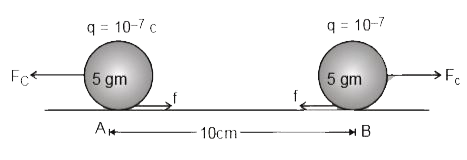Two particles, each having a mass of 5 g and charge. 1.0×10−7 C, stay in limiting equilibrium on a horizontal. table with a separation of 10 cm between them. The coefficient of friction between each particle and the table. is the same. Find the value of this coefficient.
The correct Answer is:μ=0.18
Here q1=q2=10−7C,r=10cm=10−1m
m=5g=5×10−3kg,μ=?
For limiting equilibrium,
F=μR=μmg
q1q24π∈0r2=μmg
μ=q1q24π∈0r2mg=10−7×10−7×9×109(10−1)2×5×10−3×9.8
= 0.18
Topper's Solved these Questions
- ELECTROSTATICSBOOK - PRADEEPCHAPTER - ELECTROSTATICSEXERCISE - FILL IN THE BLANKS
8 Videos
- ELECTROSTATICSBOOK - PRADEEPCHAPTER - ELECTROSTATICSEXERCISE - PROBLEMS FOR PRACTICE
8 Videos
- ELECTROSTATICSBOOK - PRADEEPCHAPTER - ELECTROSTATICSEXERCISE - VALUE BASED QUESTIONS
7 Videos
- ELECTRONIC DEVICESBOOK - PRADEEPCHAPTER - ELECTRONIC DEVICESEXERCISE - Fill in the Blanks
1 Video
- MAGNETIC EFFECT OF CURRENT AND MAGNETISMBOOK - PRADEEPCHAPTER - MAGNETIC EFFECT OF CURRENT AND MAGNETISMEXERCISE - Competition Focus (Multiple Choice Questions)
2 Videos
Similar Questions
Two particles, each having a mass of 5 g and charge. 1.0×10−7 C, stay in limiting wquilibrium on a horizontal. table with a seaprtion of 10 cm between them. The coefficient of friction beteen each partcle and the table. is the same. Find the value of this coefficient.
View SolutionTwo particles, each having a mass of 5 gm and charge 1.0×10−7C, stay in limiting equilirbium on a horizontal table with a separation of 10 cm between them. The coefficient of friction between each particle and the table is the same. Find the value of this coefficient.

View Solution
Knowledge Check
A rope of length 30cm is on a horizontal table with maximum length hanging from edge A of the table. The coefficient of friction between the rope and table is 0.5. The distance of centre of mass of the rope from A is
A5√153cmB5√173cmC5√193cmD7√173cmA body of mass 2 kg at rest on a horizontal table. The coefficient of friction between the body and the table is 0.3 . A force of 5N is applied on the body. The force of friction is
A5NB5.88NC6ND20NA body of mass 2kg is at rest on a horizontal table. The coefficient of friction between the body and the table is 0.3 . A force of 5N is applied on the body. The acceleration of the body is.
A0ms−2B2.5ms−2C5ms−2D7.5ms−2
Two particles have equal masses of 5.0 g each and opposite charges of +4.0×10−5C. They are released from rest with a separation of 1.0 m between them. Find the speeds of the particles when the separation is reducced to 50 cm.
View SolutionA particle A having a charge of 2.0×10−6C is held fixed on a horizontal table. A second charged jparticle of mass 80g stays in equilibrium on the table at a distance of 10 cm from the firsst charge. The coefficient of friction between the table and this second jparticle is μ=0.2. find the range within which the charge of this second particle may lie.
View SolutionThe friction coefficient between the table and the block shown in figure is 0.2. Find the tension in the two strings.

View SolutionA particle A having a charge 10μC is held fixed on a horizontal surface. A block of mass 80g and having charge stays in equilibrium on the surface at a distance 3cm from the first charge. The coefficient of friction between the surface and the block is μ=0.5. Find the range within which the charge on the block may lie.
View SolutionA block of mass 4 kg is resting on a horizontal table and a force of 10 N is applied on it in the horizontal direction. The coefficient of kinetic friction between the block and the table is 0.1. The work done in √20 s
View Solution